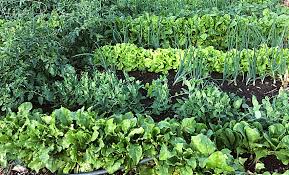
Caring for Your Garden in the Summer Heat
Temperatures are looking to rise again this week, making now a great time to talk about how to help care for your garden crops in the hot and dry times of summer. Late July through August can tend to be very hot and it is important that you are taking proper care of your crops to get them through when they are ready to be picked from the garden. Some plants can tolerate the heat better than others. When you consider that most plants are made up of 85 to 90 percent of water, it makes more sense why plants need extra attention in the heat.
First let’s talk about vegetables. According to Kathy LaLiberte from Gardeners.com, “Tomatoes, peppers, eggplant, corn, melons, and squash actually need at least a month of 80 to 90 degree weather to develop a flavorful and abundant crop.” Kathy continues to explain how these crops are “sun worshippers”, and as long as they do not run out of water, they will be good in the heat. These plants that love the heat do need lots of water while they are growing, so it is important to pay attention to their hydration levels when there is a lack of rainfall.
Cool weather vegetables should be grown either before or after the worst heat of the middle of summer. These cool weather vegetables consist of lettuce, spinach, arugula, broccoli, kale, cauliflower, peas, and cilantro. Often these plants will stop growing or give up once temperatures rise above 80 degrees. If these plants are planted on either side of the worst heat of summer, you are more likely to see a healthy crop that tastes better.
If you happened to plant cool weather vegetables too late and are worried about helping them in the heat now, using shade netting can be done to try to help the plants survive the heat. Kathy LaLiberte explains that shade netting can be placed over the plants to keep soil and air temperatures cooler (as much as 10 degrees cooler), as well as protecting the crops from extreme sunlight. Adding this protection helps prevent soil loss as well.
There are options for how you can go about protecting your plants during a heat wave. Here are 4 key reminders to remember when the temperatures start to rise or for the next time you see an “excessive heat warning” alert. First, water long, slow, and routinely to ensure your plants are hydrated well. Second, find the balance of how much you should water. Even though it is important to give the plants hydration, resist the urge to overwater. Overwatering can cause plants to wilt under high temperatures and intense sun. Starting to provide enough water well before the peak of a heat wave is good for your plants and will provide peace of mind that your plants have enough water when the heat hits. Third, when watering, be sure to water the soil instead of on the leaves. Water droplets can act like a magnifying glass and actually amplify the sun’s effects and hurt the leaves. Lastly, the fourth piece of advice is to provide shade if possible. If shade netting is not an option for you, bed sheets can be used as shade cover or umbrellas/large canopies. Potted plants can simply be moved to a shadier location.
For some plants, the heat may slow down the growing process, but only turns out to be a temporary setback. It is possible to see your plant’s production slow down, then bounce back once temperatures go back to a more manageable range for the plants. It is important to keep an eye on how the plants are looking, including signs of dehydration. Giving plants the water they need during the heat is one of the most critical steps to caring for your crop in the heat. Some cases may need additional shade or other caring measures. It can always be a good idea to keep notes of what you see happening in your garden so you can reflect at the end of the growing season and make the necessary changes for next year.